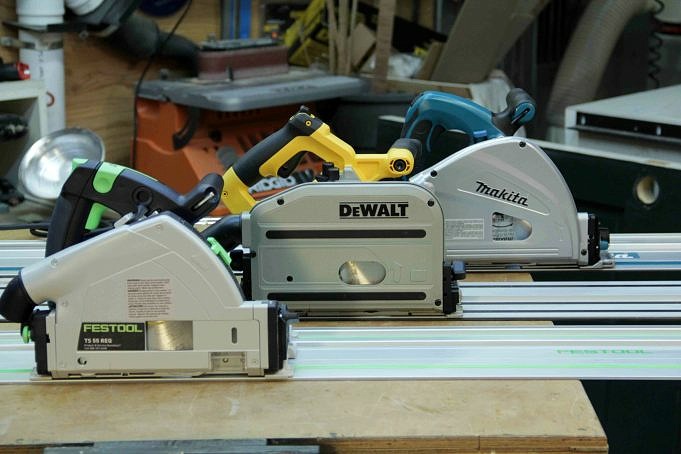About Makita
Makita has been serving professional woodworkers’ needs since 1915. We were not surprised to learn that Makita has a large selection of corded power tools and cordless powertools, thanks to their industry experience.
They make sure these tools have enough power, despite their lighter weight. Makita has a wide range of accessories and blades that can be used with different woodworking tools, which you will see if you scan their products like our team.
Our Top Pick: Makita SP6000J
The Makita SP6000J is more portable than a standard circular saw. This unit is more portable than a standard circular saw and can be moved around the jobsite with less restriction. We noticed that the Makita guides rails are anodized aluminum. This allows it to produce precise cuts without excessive tearing.
Makita track saws are lighter than others, but they still have a 12-amp motor that can run at 2000 to 5200 RPM. Makita tracksaws can also be used to make bevel cuts of up to 48 degrees angle.
Festool
Festool tracksaws were not introduced until the 1980s, despite the fact that the company was around since 1925. Festool track saws were not widely known in the industry due to their late introduction. However, they are well-known for their professional-grade quality tracks and their smooth-cutting operations.
Festool is known for its track saws and cordless tools such as drills, chainsaws, jigsaws, and drills. Festool products can be a little expensive, but they are user-oriented and are focused on providing the best efficiency and convenience.
Our Top Pick: Festool’s TS5 ReqF-Plus
Festool tracksaws such as the TS5 ReqF-Plus have guide rails that attach to them. This will allow you to make precise cuts and can be very helpful for beginners. This cordless track also has anti-tipping and a riving knife. Your new track will have less kickback than other tools, thanks to these features.
Festool’s Fast-Fix system makes it easier to change the blade. This cordless track saw can perform depth adjustments with ease thanks to its innovative plunge mechanism.
Features Of Makita SP6000J & Festool TS55 ReqF-F-Plus
Overview Of Features
Power
Both Makita track saws and Festool offer reliable power output. The Makita tracksaw has a slightly longer run time and power capacity than the Festool option due to its battery-powered limitations. The motor is 10-amp, so it can handle even the most difficult materials.
Depth Adjustment
You can adjust the angle of both the 45- and 90-degree saws. This feature is essential if you intend to make angled cuts using a tracksaw. Bevel cutting, as you might know, requires more flexibility and focus than straight cuts.
Festool and Makita have different track saw options. TS 55 REQF-PLUS allows users to control their micro-points. This guarantees the highest accuracy.
Variable Speed
It’s no surprise that Makita track saws and Festool tracksaws are made by reputable brands. Both models have industry-standard variable speeds. Both track saws can operate in a zero-load configuration and shift between 2000 RPM and 5200 RPM without any problems.
This Makita track saw has electronic controls so there is no need to worry about speed fluctuations. This feature will ensure that the RPM settings are maintained more precisely.
Performance
The springs of the Festool track proved to be more resistant than the other unit. It is important to mention that the Makita alternative has smoother operations. It also features improved release mechanisms.
Mobile track saws such as TS 55 REQF-PLUS are limited in their operational time due to their battery capacity. Track saw operations may have to stop when the battery is low. Makita’s electrical outlet is sufficient to power it.
Guide Ridge Width
A track saw that has a reliable guide rail is essential for smooth cutting. Both track saw options can deliver precise cuts, which is a good thing.
If you measure the units like we did, however, you’ll find that the Makita tracksaw is.3mm larger than Festools guideridge.
Splinter Guard Strip
Track saw users will know that you can tear your first cut. The units in this comparison post have a splinter protector strip which reduces the possibility of tearing and improves cutting precision.
It was easy to see that Makita used softer material to make their guard strips. Regardless, the rubber-like construction makes it good for accuracy.
Festool, on the other hand designed its track saw selection using a hard polymer. This material increases the tool’s precision.
Non-slip Strips
Our teams also discovered that both tracks have non-slip stripes. This feature gives users a safer cutting experience and adds an extra layer of safety.
These strips allow both tools to grip the rails tightly and can move freely without interruption. In this Festool track vs. Makita comparison, it is evident that Makita has a narrower strip material.
Glide Strips
Glide strips are another feature that will make cutting easier. This component carries the track saw’s weight, which creates friction during cutting sessions.
You might assume that these track saws look similar at first glance. We can assure you that Makita’s top surface is wider and more serrated than Festool’s.
Extra Features
High-powered cutting tools such as these track saws require reliable dust ports. Both units have similar dust collection systems, but Makitas inserts don’t get in the way, unlike Festool.
Festools riving knives are a great tool safety option. They prevent rip cuts which can lead to kickback. This helps to keep the piece in its place, so that it doesn’t come into contact with the teeth of the blade.



